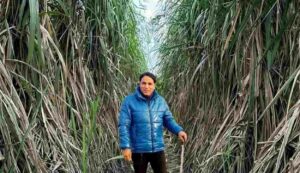Success Story: This farmer from UP got success from sugarcane cultivation
Success Story: With their diligence and knowledge, certain farmers in today’s agricultural industry have not only made agriculture a profitable enterprise, but they have also inspired others. Sartaj Khan, a farmer from Uttar Pradesh’s Shahjahanpur area, is one such individual. In addition to his success growing sugarcane, Sartaj Khan has shown a new approach in agriculture by using contemporary methods. The success story of Sartaj Khan is a prime example of a forward-thinking farmer who is leading by example in the agricultural community.

On 50 acres of land, Sartaj now grows a wide range of sugarcane, including the enhanced variety 13235. His yearly sales exceed Rs 1 crore as a result of the average output of 120 quintals per bigha and around 720 quintals per acre. Tell us in detail about his success story today in such a scenario.
Starting and maintaining a family custom
For over half a century, Sartaj Khan’s family has been engaged in sugarcane cultivation. Sartaj Khan is continuing his father’s history of growing sugarcane, which he started in the past. Sartaj Khan was born in a tiny hamlet in the Shahjahanpur area, and farming was a big part of his life from the start. From an early age, his father taught him the ins and outs of farming and taught him that farming is a respectable job that balances all facets of life, not simply a career. In this sense, Sartaj saw farming as a vital method to support his community as well as a source of income.
founding of Shahid Farms and the production of sugarcane
Sartaj Khan is a forward-thinking farmer who owns 70 acres of land, 50 of which he uses for sugarcane cultivation. In addition, he develops sugarcane nurseries in select areas, which he sells to farmers in the area. In this manner, he assists and motivates people in the agricultural industry in addition to making money from his farming. “Shahid Farms” is the well-known name of Sartaj Khan’s property. In addition to growing sugarcane, this farm is renowned for its diversified cropping and use of contemporary farming methods.
Modifications to sugarcane production and adoption of superior cultivars
About ten years ago, Sartaj Khan changed the way sugarcane was grown, continuing his father’s heritage. In the past, he produced a strong yield by growing sugarcane types 0238 and several others. However, after a few years, this variety’s disease issue began to worsen, which had an impact on yield. Then, after three years of successful cultivation on his farm, Sartaj shifted to the newly enhanced sugarcane types 13235, 0118, 14201, and 16202. This cultivar is not only producing a high yield, but it is also more disease-resistant.
How sugarcane is grown
Sartaj Khan is a forward-thinking farmer who cultivates sugarcane using contemporary methods. He grows sugarcane using the trench technique, which involves growing two-eyed buds or pieces of sugarcane before sowing them. Sugarcane germinates almost 100% of the time using this procedure. In order to prevent weeding issues, he maintains a space of 2.50 to 4 feet between rows. For crops that are 2.50 feet away, he uses a power tiller; for crops that are 4 feet away, he uses a small tractor.
The value of mixed crops
According to forward-thinking farmer Sartaj Khan, mixed planting is crucial to the production of sugarcane. He grows mustard, cauliflower, cabbage, wheat, peas, gram, and knol-khol in addition to sugarcane in the fall. In addition to making him money, this almost covers the expense of growing sugarcane. In summer sugarcane agriculture, he also uses mixed cropping, which is a great approach to broaden agricultural and output variability.
Fertility and soil test
Sartaj Khan believes that soil testing is crucial to the success of sugarcane farming. A soil test identifies the nutrients that the soil is deficient in and the fertilizer that needs to be applied to make up for them. This improves the sugarcane crop’s output in addition to its quality.
On his farm, he practices both chemical and organic cultivation. He employs vermicompost and cow dung manure for organic farming, and he uses organic manure and chemical fertilizers as needed for chemical farming.
Advice for increasing yield
According to Sartaj Khan, agricultural experts should advise farmers while they are cultivating. Farmers should do this by attending seminars and learning about the government’s current programs and resources. They may learn about new kinds, disease prevention strategies, and contemporary procedures while also increasing the productivity of their farms in this manner.
Farm-related activities
Herbicides are never used on Sartaj Khan’s property. According to him, using herbicides temporarily halts plant development, which may have an impact on the crop’s health. Rather, he favors organic approaches and uses natural means to safeguard crops. His whole farm is devoted to chemical and organic farming, which supports a steady and well-balanced agricultural system.
Profit and economic success
In one acre, Sartaj Khan’s farm yields 7 lakh 200 buds. The cost of growing sugarcane, if we include the seeds or buds, is Rs 40,000 per acre. He thinks that choosing high-quality sugarcane varieties, mixed cropping, using both chemical and organic fertilizers appropriately, and using the proper procedures may all increase agricultural profits. The 13235, 0118, 14201, and 16202 types now produce an average of 120 quintals per bigha and around 720 quintals per acre.
Farmers may not only better their economic situation but also demonstrate a new path in the agricultural sector if they use their expertise and hard work in the proper way, as shown by the success story of Sartaj Khan, a progressive farmer.

